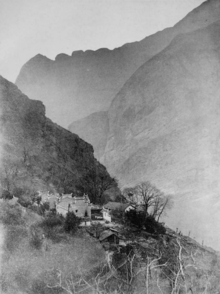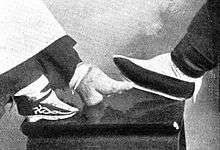Alicia Little
Alicia Little or Mrs Archibald Little (1845 – 31 July 1926) was a writer and a British campaigner for women's rights and later against foot binding in China.
Alicia Little | |
|---|---|
.jpg) Mrs Archibald Little | |
| Born | 1845 Madeira |
| Died | 31 July 1926 (aged 80–81) Kensington |
| Nationality | British |
Life
Little was born as Alicia Ellen Neve Bewicke[1]in Madeira islands, Portugal, in 1845 to Calverley and Amelia Jane Bewicke. Her parents owned Hallaton Hall in Leicestershire but she was brought up in Madeira. She returned to England and successfully published her first tranche of books. She travelled abroad but she was based in England until 1886.[2]
She campaigned in 1885 when she published Mother Darling. This novel highlighted the poor status of women's rights in British marital law. At the time a man might not only exclude an estranged wife not only from "his" property but also access to their children. This was alleviated by the Married Women's Property Act 1893.[2]
She married Archibald John Little and called herself "Mrs Archibald Little" in 1887. They went to live in Chongqing where she was seen as an oddity. Women did not go out in public as she wanted to so she had to spend time challenging their expectations.[2] They had been refused permission to build a holiday home by a magistrate who feared a public backlash. The magistrate arranged for them to stay at a farm in the hills near the Yangtse River as they avoided the summer heat at their home in Chongqing. Whilst they were there they were robbed and Little explains how she had to cope without a mirror, tablecloths and the time - as their watches had been stolen.[3] Both of them travelled around China although Little had to dress as a male to avoid attracting attention which had on occasion resulted in items being thrown.[2]

Little kept a diary during 1893-1894 which she prepared for publication. In 1894 she met the photographic printer Kazumasa Ogawa whilst they were visiting Japan. The diary became to basis of a well bound book. Ogawa supplied photographs and it was published as My Diary in a Chinese Farm. The book described her stay on the farm near the Yangtse River.[3]
She was a writer who was known for her campaign against foot binding. She was the leading European campaigner from 1896 to 1906 against this practice.[2] In 1898 she founded Tien Tsu Hui (Natural Foot Society) which campaigned against the Chinese custom of binding the feet of girls and women.[4] The organisation initially took ex-pats as members and Little realised that she needed to not confuse her message with religion.[2] In 1899 she published her book "Invisible" China which was a 600-page book which was amply illustrated by over 100 of her photographs. The book covered a variety of subjects but foot binding again got attention.[5] Little with the support of her husband organised a campaign of postcards and Little set out to deliver talks in leading cities in China, Hong Kong and Macau. Little delivered these talks using x-rays of the deformed feet and with quotes from Confucius. She had seen and written about the effects of this custom where children's feet and toes were broken before they were bound to prevent normal growth. Women with bound feet had to work in the fields on their knees because they could not stand and women killed themselves during wars because they knew that they could not run.[2]
Her 1902 book Out in China was reviewed at the time as a "political pamphlet" the story involves the wrong woman being sent from Britain to marry a man in China. The story ends with the wedding party being murdered by Boxers.[6]
In 1908 her husband died and she took time to complete the publication of his book which was published as a joint effort. The book which was published in 1910 was one of the first in English to describe the province of Yunnan.[7]
Little died in Kensington.
Legacy
Little is unusual in being one of the few women who outshine their husband in the ODNB. Her work on foot binding was well received but has now been seen as expressing British cultural superiority. Her work has been compared with some external approaches to the custom of FGM in Africa in the 21st century.[4]
Works include

- Flirts and Flirts: or, A Season at Ryde (1868)
- One Foot on Shore: A Novel (1869)
- Love me for my Love (1869)
- Last of the Jerninghames (1873)
- Lonely Carlotta: "a crimson bud of a rose" (1874)
- Onwards! But Whither?: A Life Study (1875)
- Margery Travers (1878)
- Miss Standish, and By the Bay of Naples (1883)
- Mother Darling (1885)
- A Marriage in China (1896)
- My Diary in a Chinese Farm (1896)[3]
- Intimate China (1899)[5]
- Li Hung-Chang: His Life and Times (1903)
- Across Yunnan: A Journey of Surprises (1908) on behalf of her late husband
References
- In many of her books Neve appeared as Neva.
- Sybil Oldfield, Little , Alicia Ellen Neve (1845–1926), Oxford Dictionary of National Biography, Oxford University Press, 2004; online edn, May 2007 , accessed 9 Nov 2016
- Charlotte Mathieson (6 October 2015). Gender and Space in Rural Britain, 1840–1920. Routledge. pp. 145–155. ISBN 978-1-317-31882-8.
- Gail Marshall (2 August 2007). The Cambridge Companion to the Fin de Siècle. Cambridge University Press. pp. 103–. ISBN 978-0-521-85063-6.
- Alicia E. Neva Little (10 June 2010). Intimate China: The Chinese as I Have Seen Them. Cambridge University Press. ISBN 978-1-108-01427-4.
- book review of Out in China, 1902, The Spectator
- Archibald John Little; Alicia Little (31 October 2010). Across Yunnan: A Journey of Surprises. Cambridge University Press. ISBN 978-1-108-01409-0.